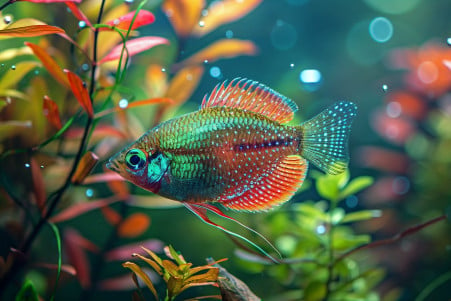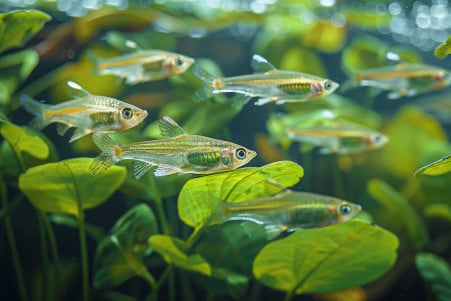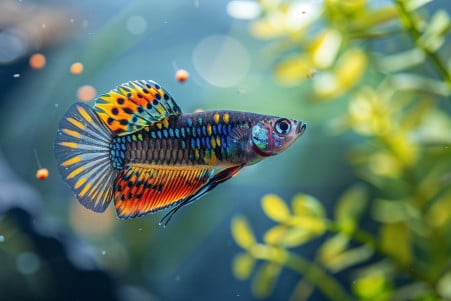What Do Mystery Snails Eat? An Aquarium Guide
4 May 2024 • Updated 4 May 2024

If you're interested in adding mystery snails to your aquarium, it's important to know what mystery snails eat so that you can make sure they have the right food sources to stay healthy and happy. Mystery snails are omnivores that eat algae, decaying plant matter, fish food, and blanched vegetables like zucchini and cucumber, and they can also consume small amounts of fish or shrimp pellets.
Below, we'll go into more detail about the best mystery snail diet based on information from aquarium experts and aquatic biologists. This way, you can make sure that your mystery snails are able to do their part to help keep your aquarium's ecosystem in balance. Let's get into the specifics of what makes a good snail snack.
What do mystery snails eat?
Best Vegetable Options for Mystery Snails
Mystery snails are omnivores, so they need a mix of plant and animal-based foods in their diet. In terms of vegetables, they can eat a variety of blanched options like zucchini, cucumber, lettuce, and spinach. Leafy greens like romaine, kale, and spinach are great options because they offer nutrients and calcium that are important for keeping their shells healthy and strong.
Make sure to feed vegetables in moderation and remove any leftovers quickly to keep the water quality up. Feeding a variety of vegetables will help make sure that your mystery snails are getting a well-rounded diet. To prepare the vegetables, blanch them for 1-2 minutes to soften them and then add them to the tank. This will make them easier for the snails to eat.
Using Commercial Snail Foods
In addition to fresh vegetables, you can also feed mystery snails commercial snail foods, such as algae wafers and sinking pellets. The Mystery Snail - Care Guide from Aquatic Arts explains that these foods contain important nutrients and can be used to add extra protein and calcium to their diet. The Mystery Snail Care Guide from Shrimpy Business also lists algae wafers and sinking pellets as part of a well-rounded mystery snail diet.
That said, you should feed these foods sparingly to prevent overfeeding and dirty water. You should also make sure that any commercial foods you feed your snails are copper-free, as copper is poisonous to invertebrates like mystery snails, as mentioned in the Feeding Mystery Snails thread on the C.A.R.E. forum.
How Often and How Much to Feed Mystery Snails
Mystery snails have small appetites and should be fed conservatively to avoid overfeeding, says the Mystery Snail Care, Diet, Feeding, Shell Size & Tankmates - Video. A good rule of thumb is to feed them every 2-3 days and only give them as much food as they can eat in a few hours. The How often/much to feed my Mystery Snail? thread on the Betta Fish Forum explains that there isn't a set feeding schedule, but you should feed them conservatively.
Any food that goes uneaten should be removed as soon as possible to prevent water quality issues and potential health problems. You can monitor how much you feed your snails based on how much they eat and adjust portion sizes as needed to make sure they're getting enough food without being overfed. This will ensure that they stay healthy and their shells grow properly, which will be important as we move on to talk about the role of calcium in the next section.
Calcium Needs and Shell Health
Calcium is important for mystery snails to keep their shells healthy and strong and to help with egg production. Per the Freshwater Mystery Snails: A Comprehensive Guide from Aquatic Arts, calcium can be supplemented through calcium-rich foods like kale and spinach, by floating a cuttlebone in the tank, or by using additives.
Symptoms of calcium deficiency include lethargy, slow growth, and hindered reproduction. Per a study cited by Crayfish Empire, a diet mass (DM) of 12% or less in calcium carbonate will lead to good, consistent growth in land snails. They recommend that the DM of calcium carbonate in aquatic snails be 5% or less.
Proper water parameters, including pH, GH, and KH, are also important for calcium absorption and shell health. Per the Calcium in Freshwater Snail Aquariums article, freshwater snails will get enough calcium from their tank water as long as the source water has the right calcium hardness (70-90 mg/L calcium).
Using Mystery Snails to Control Algae
Mystery snails can help keep algae under control in aquariums, especially hair algae. Per Aquariadise, mystery snails are mostly herbivorous and will eat biofilm, detritus, dead plant matter, and most types of algae. Their radula, which is a tongue-like organ with tiny teeth, enables them to tear and scrape away algae that's growing on the glass and decorations in an aquarium.
That said, per the Life with Pets GCI website, mystery snails are not big cleaners and need a balanced diet. One issue is that they can stop eating algae if they are fed too many other foods like fish flakes. To ensure they eat algae, make sure they are not fed too much and are instead able to eat biofilm and algae. This balance between feeding them and letting them eat algae will help them stay healthy and do their part to keep the aquarium clean.
Avoid any food product, medication, or plant fertilizer that contains Copper of any form. Copper is toxic to invertebrates. Many commercial fish foods, medications, and plant fertilizers contain copper or more commonly copper sulfate. Always look at the ingredient list for any product going into the aquarium to ensure they are copper free.
Conclusion: Providing a Balanced and Varied Diet for Healthy Mystery Snails
Mystery snails thrive on a varied diet that includes both plant and animal matter sources. Offering a rotation of blanched vegetables, algae wafers, and sinking pellets can provide a well-rounded diet.
Calcium supplementation and proper water parameters are crucial for shell health and reproduction. By understanding their dietary needs, you can ensure your mystery snails play their role in maintaining a balanced aquarium ecosystem.


